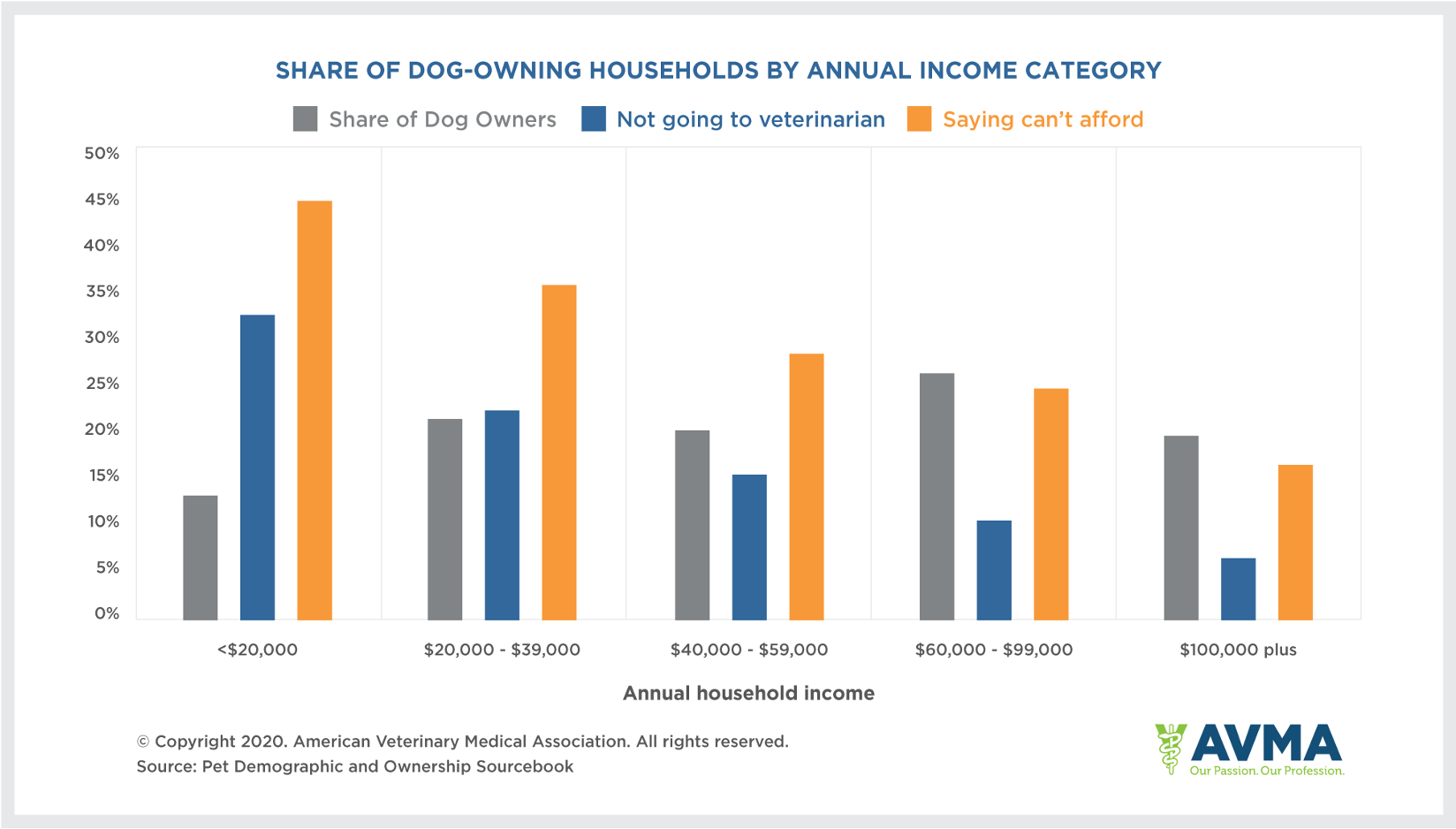Discussing the costs of pet care during a veterinary exam is probably one of a veterinarian’s least-favorite things to do. However, open discussions about pet health fees couldn’t be more important than they are right now.
The coronavirus pandemic is still raging across the globe. The U.S. economy has incurred more than double the amount of job losses during the Great Depression. Since the start of the coronavirus outbreak, 25% of adults have experienced difficulties paying bills.

Most Americans have fewer financial resources than they did pre-pandemic. They’re having to evaluate expenses with more scrutiny and cut back in areas. And in many cases, these tough decisions on where to spend or save resources affect their pets. In a September 2020 survey of pet owners, VitusVet found that over one-third of pet owners put off pet care due to costs, and one-fifth of pet owners deferred a service due to price – both in the last 6 months.
Practice staff are noticing this cost-conscious behavior as well. According to a report by the Veterinary Hospital Managers Association (VHMA), over one-third of practice staff surveyed said clients are more concerned about pet health costs than they were pre-pandemic.
When money is tight and pet owners are more financially stressed than ever, it’s critical to address pet health costs head-on. VitusVet’s October webinar covered “The Money Talk” to help veterinarians and practice staff successfully navigate financial conversations with pet owners. Our panel of experts included:
- Debbie Boone, 2 Manage Vets Consulting
- Melissa Supernor, CVT, VTS, CFE, CCFPEdAVT
- Katie Rice, CVT, Outpatient Zone Leader, Cleveland Heights Animal Hospital
- Debra Vey Voda-Hamilton, Hamilton Law & Mediation, PLLC
- Mark Olcott, DVM, Founder & CEO of VitusVet
Here’s what they had to say about carefully and respectfully talking through pet health costs with stressed pet owners.
Start with Empathy.
It’s a given that veterinary professionals are animal lovers. Their main goal is to preserve the health of their clients’ pets. However, the end result doesn’t always play out that way. That’s why it’s so important to begin all conversations with empathy in mind. Trying to understand what clients are going through is the first step towards the end goal of a healthy pet.
Due to the coronavirus pandemic, the client experience with your practice has probably changed pretty drastically. Clients aren’t in the waiting room or the exam room anymore. After your staff picks up their pet, clients are in their car, waiting by the phone. Emotions are already running high because of Covid-related stress. Layer on top of that a sick pet and a lack of connection, and you could have a very scared, stressed client on your hands.
Melissa Supernor knows the experience all too well. She recently took her sick cat to the vet and shared her story. “To release my pet, even though I trust those people greatly, was a very different experience,” she said. “It’s so quiet. There’s no one to talk to. When you’re in the hospital, you hear noises, dogs barking. There was none of that.”
As Melissa waited for her cat, she began to worry more. “I felt so lonely. I have a very sick cat, and I began to wonder, what am I going to do for her? My thoughts went wild on me – I was just so scared of what was going on with her. And that’s not to say they weren’t communicating with me. I was getting texts with pictures of her x-rays. They were keeping me informed, but I was just so much more lonely than when I was in the hospital.”
In order to have empathy, veterinary staff need to find out exactly what’s going on for clients like Melissa. That starts with getting curious and asking questions in the moment. “Vet techs are really on the front lines, going out to cars and dealing with these emotions,” said Debbie Boone. “If we can learn to be curious about why someone just yelled at the vet tech while they took a pet out of the car, it helps to diffuse the situation.
Don’t Make Assumptions.
The chart below comes from the American Veterinary Medical Association. It shows dog-owning households by income category. Based on income level, veterinary staff might make assumptions about a client’s ability to pay for pet health care. However, those assumptions don’t always line up with reality. Just look at the percentage of dog owners in the $100K+ category who say they can’t afford care

“Do not x-ray the client’s pocketbook,” said Melissa Supernor. “I worked at a low-income veterinary clinic, and a huge percentage of our clients did whatever they could to care for their pets. We really worked with them on treatment plans, giving them the best tools we could. How much can they do on their own at home for their pet, in lieu of the standard in-clinic services?”
At the other end of the spectrum, Melissa also saw clients in general practice who seemed financially stable but said “no” to pet health costs. “When we see someone in an expensive car and they say no, it makes us wonder if it is really true. But then again, I could be that same person who makes a good living and has a nice car. And I would not want that same assumption made of me.”
When offering clients pet health services and the associated costs, it’s critical to make the offer with no prior assumptions. A client’s income level and how they appear are not necessarily indicative of whether or not they can or will pay. “It is rather arrogant on our part, to decide for clients what they can afford,” said Debbie. “Let them make their own choice.”
Create Consistency.
One thing that can be especially difficult for veterinarians is making interactions with clients consistent across the practice. Each veterinarian, vet tech, and even practice staff member has their own personality and style of care. Clients may stick with one veterinarian because they prefer his or her style.
Let’s face it: each person’s style is probably not going away any time soon. However, one way to make it easier for clients to interact with anyone in the practice is to create a consistent standard of care. This standard of care also has a big bonus: it cancels out staff behavior based on assumptions, because each client is supposed to be treated the same.
“It really helps alleviate any judgments or assumptions of what clients may or may not do,” said Katie Rice. “We have a standard of care that we start with and go from there. Of course, we adjust accordingly, giving clients multiple options. They have different avenues and do not feel trapped by one thing.”
These standards of care can be anything from very routine activities like vaccine protocols to how all staff interacts with a client about their pet. “All practice staff are involved with any given pet. So in our best-case scenario, every time Fluffy comes into the clinic, every staff member understands Fluffy’s problem and what needs to be done,” said Melissa. “If the client calls back after Fluffy leaves, the customer service rep (CSR) answering the phone can answer both financial and basic medical questions.”
Deborah Vey Voda-Hamilton added that it’s critical for veterinarians to start the financial conversation with clients. “The client is not going to take that money conversation as well from the front desk as they would from their veterinarian. They can ask questions to their veterinarian, and he or she can also get curious about how the client is feeling.”
Be Consultative.
Gone are the days of any type of doctor being the end-all authority for patients, making decisions on their behalf and moving forward. Today’s pet owner needs several things from their veterinarian: information and choices.
“I view myself as a neutral consultant or almost a coach,” said Dr. Mark Olcott. “When I speak with clients, I lay out all of their options – from the Cadillac approach all the way down to nothing. They could turn around and take their pet home right now. That might be a terrible idea, but they do have that option.”
Pet owners do not come in the door without worrying about money – especially in an emergency practice. Giving them an idea of costs for any of the options you provide is critical. And do it as soon as possible. “A very uncomfortable conversation is walking into a room with the owners of a 12-year-old cat that is 10% dehydrated and has diabetic ketoacidosis,” said Mark. “If you say, ‘Listen, it is going to be $5,000 even to start, right? If that’s not feasible, let us talk about other options because you do have them.’”
There’s a wave of relief that comes over people even just by acknowledging that the right choice can sometimes by euthanization. “There’s always the old ‘We can, but should we?’”, said Debbie. “We can do a lot for pets if money is no object, but what about the well-being of the animal?”
Katie’s practice uses this same consultative approach. “What can we do now? What can we wait on? Just talk clients through it and let them know, ‘I am in your corner. We’re in this together.’”, said Katie. “It helps them feel like it’s a partnership to get the best care for their pet. Being upfront and honest gets a much better response from clients. They really appreciate it.”
Partner With Clients For Better Pet Health.
Remember: this collective experience is happening to all of us. Covid-19 is impacting people in unimaginable ways. Pet owners are scared. Staff are stressed. And it’s not going away any time soon.
The best way to improve pet health outcomes and client satisfaction simultaneously is to treat pet owners like true partners. Learn where they’re coming from and empathize. Check your assumptions about what they can and can’t afford. Create a consistent experience so they know what to expect from everyone in your practice. And be their pet health consultant: talk them through their options and help them decide what’s best for them.
Want to learn more tips from our webinar, “The Money Talk”? Download the recording here.
 by a veterinarian
by a veterinarian


